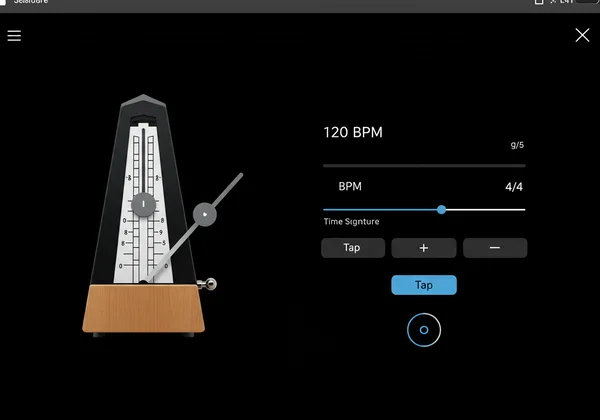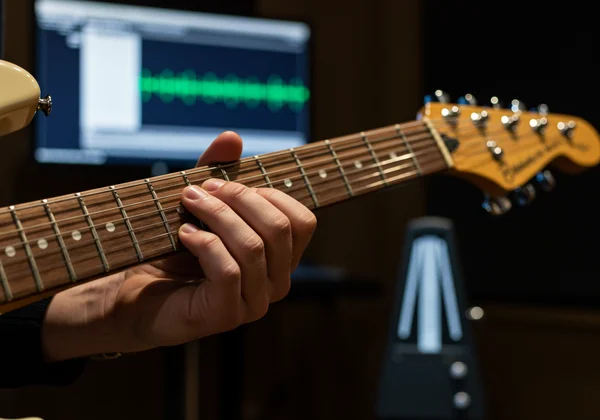Master Rock Riffs: 15 Songs with Our Online Metronome BPMs
Ever felt that surge of excitement hearing an iconic rock riff, grabbing your instrument, and trying to play along, only to find it sounds… a little off? You’ve got the notes right, but the timing feels loose. Unlock the secret to playing your favorite rock anthems with professional precision. The key isn't just passion; it's a steady beat. Discover why practicing with an online metronome is crucial for mastering these legendary riffs. Can a metronome improve my rhythm? Absolutely, and our free online tool is here to help you nail every single beat with confidence.

Why Practice Iconic Rock Riffs with a Metronome?
Before diving into the songs, let's understand why a metronome is the most valuable practice partner a musician can have. Rock music is built on a foundation of solid, driving rhythm. From the thunderous kick drum to the chugging guitar, every element needs to be locked in. Practicing with a metronome doesn't just make you play in time; it fundamentally rewires how you perceive and execute rhythm.
Building Precision & Groove for Your Playing
A metronome is your objective guide to rhythmic accuracy. It exposes the subtle inconsistencies in your playing—the moments you rush a fill or drag behind the beat. By consistently practicing with this unwavering click, you train your muscle memory to perform with pinpoint precision. This transforms your playing from amateurish to professional, giving your riffs the tight, punchy groove that makes heads bang and feet tap. The steady pulse helps you internalize complex rhythms and play them effortlessly.
Unleashing Your Inner Rhythm Machine
The ultimate goal of using a metronome is to not need one. Consistent practice develops your internal clock, a subconscious sense of timing that stays with you even when the click stops. You become the source of the rhythm, able to drive a band or play solo with unshakeable confidence. This inner rhythm machine allows you to play with more expression and dynamics, knowing that your foundational timing is rock-solid.
How to Use Our Online Metronome for Practice
To get the most out of your practice sessions, you need a tool that is both powerful and easy to use. Our free metronome online is designed for musicians of all levels, providing the features you need to master any song. It's a versatile BPM tool that works right in your browser on any device, with no downloads required.
Setting Precise BPMs and Time Signatures
Accuracy starts with the right settings. For each riff listed below, you’ll need to set a specific BPM (Beats Per Minute). On our homepage, you can easily adjust the tempo using the slider, the "+" and "-" buttons for fine-tuning, or by typing the exact number. Most rock songs are in a 4/4 time signature, which is the default setting. However, you can easily change the time signature metronome for more complex pieces, ensuring every beat and accent is right where it should be.

Leveraging Tap Tempo for Unknown Riffs
What if you're trying to learn a riff that's not on this list? That's where our unique tap tempo feature comes in. Simply listen to the song and tap along to the beat on the "Tap" button. Our tool will instantly calculate the BPM for you. This is an incredibly powerful way to quickly find the tempo of any song and start practicing it accurately without searching for information online. Give the tap tempo feature a try!
15 Famous Rock Riffs & Their Exact Metronome BPMs
Ready to rock? Here are 15 legendary riffs with their exact BPMs. Set our online metronome to the specified tempo, start with a slow and steady practice, and gradually build up to the original speed.

Riff 1: "Smoke on the Water" (Deep Purple) - 114 BPM
This is arguably one of the first riffs every guitarist learns. Its simple, powerful structure is perfect for developing picking consistency. Set the metronome to 114 BPM to capture that classic, blues-rock feel.
Riff 2: "Back in Black" (AC/DC) - 92 BPM
Angus Young’s masterpiece is all about groove and power. At a solid 92 BPM, this riff teaches you the importance of space between the notes. Lock into that tempo to make it punchy and impactful.
Riff 3: "Sweet Child o' Mine" (Guns N' Roses) - 125 BPM
Slash's iconic opening arpeggio requires clean, precise picking. Practicing this at 125 BPM will help you nail the timing of each note and ensure the pattern flows smoothly.
Riff 4: "Seven Nation Army" (The White Stripes) - 123 BPM
Simple, memorable, and powerful. This riff is a masterclass in rhythmic simplicity. Play it at 123 BPM to capture the stomping, anthemic vibe that fills stadiums.
Riff 5: "Whole Lotta Love" (Led Zeppelin) - 90 BPM
Jimmy Page’s heavy, swaggering riff is a cornerstone of hard rock. The 90 BPM tempo feels slower, but it demands perfect timing to maintain its heavy groove.
Riff 6: "Sunshine of Your Love" (Cream) - 115 BPM
Eric Clapton's iconic, blues-driven riff is instantly recognizable. At 115 BPM, focus on hitting each note with confidence and letting the rhythm breathe.
Riff 7: "Smells Like Teen Spirit" (Nirvana) - 117 BPM
The anthem of a generation. The clean-to-distorted dynamic is key, but it's all held together by a driving 117 BPM rhythm. Practice the "chunky" strumming pattern in perfect time.
Riff 8: "Iron Man" (Black Sabbath) - 75 BPM
Doom metal starts here. This riff is slow and menacing. At just 75 BPM, it's a great exercise in rhythmic control and playing with deliberate, heavy timing.
Riff 9: "Enter Sandman" (Metallica) - 123 BPM
One of Metallica’s most famous riffs, its clean intro builds into a heavy monster. Nailing the syncopation at 123 BPM is crucial to giving it that signature metal crunch.
Riff 10: "(I Can't Get No) Satisfaction" (The Rolling Stones) - 136 BPM
This fuzzed-out riff defined a decade. It's deceptively simple but requires a relentless, driving energy. Lock in at 136 BPM to capture its rebellious spirit.
Riff 11: "Come As You Are" (Nirvana) - 120 BPM
Kurt Cobain’s watery, chorus-drenched riff has a hypnotic feel. The 120 BPM tempo is steady and deliberate, perfect for practicing note clarity and timing.
Riff 12: "Another One Bites the Dust" (Queen) - 110 BPM
While famous for its bassline, John Deacon's riff is a funk-rock masterpiece. Playing this at 110 BPM on any instrument is a fantastic lesson in groove and syncopation.
Riff 13: "Beat It" (Michael Jackson) - 138 BPM
Featuring Eddie Van Halen, this riff is pure 80s rock energy. The up-tempo 138 BPM will test your precision and stamina. It’s a fantastic riff for speed training.
Riff 14: "Eye of the Tiger" (Survivor) - 109 BPM
The ultimate workout anthem. This palm-muted, chugging riff demands rhythmic precision. Set your metronome to 109 BPM to build your own musical fighting spirit.
Riff 15: "Living on a Prayer" (Bon Jovi) - 123 BPM
Richie Sambora's talk-box intro and driving verse riff are pure arena rock. At 123 BPM, this song is all about high energy and tight, rhythmic playing.
Your Journey to Rock Rhythm Mastery Starts Now!
You now have the BPMs and the tools to master some of rock's greatest riffs. Remember that the key is consistent, deliberate practice. Start slow, lock in with the beat, and only increase the speed once you can play the riff perfectly. Our free metronome is always here to be your reliable practice partner. Open it up, pick a riff, and start your journey to becoming a rhythmically precise rock machine.

Frequently Asked Questions About Metronome Practice
What is a good BPM for practice?
A good BPM for practice is always slower than the original song's tempo. A great rule of thumb is to find the speed where you can play a passage perfectly without any mistakes. Start there, and gradually increase the BPM by 4-5 beats at a time as you get more comfortable.
Can a metronome really improve my rhythm?
Yes, unequivocally. A metronome provides instant, objective feedback on your timing. It builds muscle memory for accurate playing, develops your internal clock, and helps you understand subdivisions of the beat, transforming your rhythmic abilities from inconsistent to rock-solid.
What does BPM stand for in music?
BPM stands for Beats Per Minute. It is the standard unit of measurement for tempo in music. For example, a tempo of 120 BPM means there are 120 beats every 60 seconds, or exactly two beats per second.
How do I find the tempo of a song if I don't know the BPM?
The easiest way is to use a tool with a tap tempo feature. Listen to the song's drum beat or core rhythm and tap along on the designated button. Our online metronome has this feature built-in, allowing you to quickly and accurately discover the BPM of any song you want to learn.